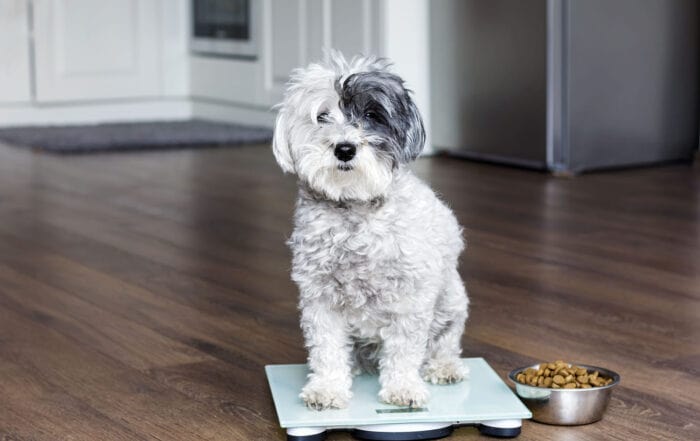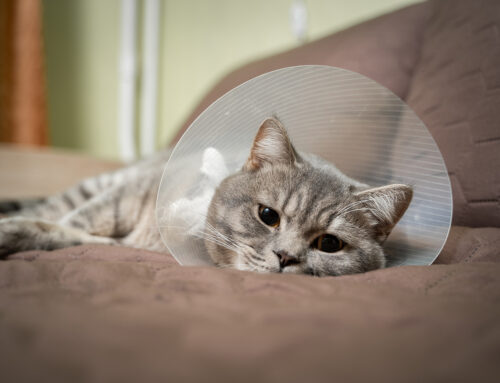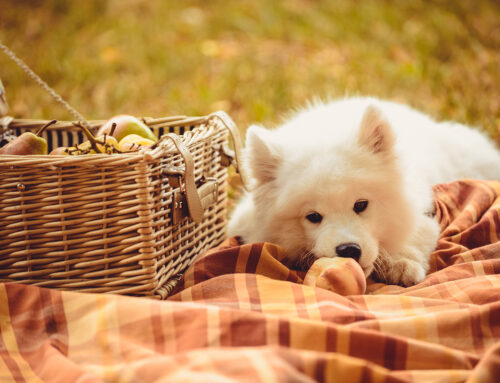Why is weight control important?
Over half of all dogs and cats (59% and 52% respectively) in the UK are overweight or obese. This means every other consult with our clients could be with a patient who is too heavy.
Overweight animals have a significantly reduced lifespan (by up to 2 years in certain dog breeds). They are predisposed to arthritis, which is often more severe at an earlier age, and other conditions including diabetes, heart problems and certain types of cancer.
Is my pet overweight?
Although assessing your pet’s bodyweight is useful to assess trends, weight is only half the picture. Checking your pet’s body condition gives you and us a more accurate indication of whether your pet is currently overweight.
Ideally you should be able to:
- Feel ribs without significant fat coverage
- See a waistline when looking at your pet from above
- See a tucked abdomen when looking at your pet from the side
Assessing your pet’s weight can be difficult, particularly in fluffy and heavy coated animals. If you are in any doubt, please come to see us for advice. We can provide an accurate body condition and ideal weight for your pet.
Why is my pet overweight?
While there are several possible causes contributing to your pet being overweight, the reason animals become overweight can be boiled down to them having a calorie intake exceeding their ability to burn calories off with exercise.
Excessive portion sizes are often the main culprit. And don’t forget treats! Treats are almost always high in calories and given on top of their normal diet. For example, a slice of buttered toast given to a dog is the equivalent of 3 bags of crisps eaten by a human, and a small slice of cheese (30g) is equivalent to one and a half chocolate bars.
As pets get older, or after being neutered, their metabolism can slow down, meaning fewer calories are needed. In addition, certain medical conditions, including hypothyroidism (an underactive metabolism) and Cushing’s disease (a change in the body’s natural steroid hormones), can make pets more likely to put on excessive weight.
How to control my pet’s weight?
Don’t aim for a crash diet, just like with people it is unsustainable and when it fails your weight (or your pets’) will often rebound. Instead, we recommend aiming for 1% body weight loss per week until your pet’s target weight is reached (e.g. 100g for every 10kg of body weight).
1. Reduce total portion size
Reducing your pet’s total calorie intake is a crucial part of weight loss. We recommend measuring your pet’s meal size, so you know how much they are currently being fed. Reduce their total daily intake by 10% initially. If weight loss is not seen, portion size can be further reduced by 5% per week until weight loss is seen. Most pets love their food. Consider giving multiple smaller meals so that they don’t feel as hungry when their portion size is reduced.
2. Consider a change in diet
While weight loss can often be achieved solely by reducing your pet’s portion size of their current food, there are diets on the market specifically designed to help your pet lose weight. These typically have increased bulk and reduced calories, meaning that your pet does not feel as hungry during weight loss. We can provide you with advice regarding food brands that can be helpful.
3. Reduce treats
You don’t need to cut out treats entirely. However, it is often surprising how many treats pets receive per day, and how high in calories many treats are. Consider swapping to low calorie pet treats, or using alternatives including carrot sticks or apple segments.
4. Consider use of puzzle bowls
Puzzle bowls are designed to slow down how quickly your pets eat. For many pets this can mean that they feel fuller at the end of mealtime, rather than gulping their food and continuing to feel hungry.
5. Don’t give in to begging
Pets often beg or whine for food if they know it will get them more treats. Be strong! If you do not give in to begging, they will learn that this behaviour is not effective.
6. Increase exercise
Any increases in your pet’s exercise levels will help them burn off the calories. For dogs, try to increase the length of their walks, or encourage them to be more active by chasing a ball or going swimming. It can be difficult to encourage cats to be more active, but try to find the right toy which attracts their attention.
Please do not hesitate to come and discuss weight management with us, as weight loss can be hard. With our support, we can get you on the road to success and start a happier and healthier life for your pet.





